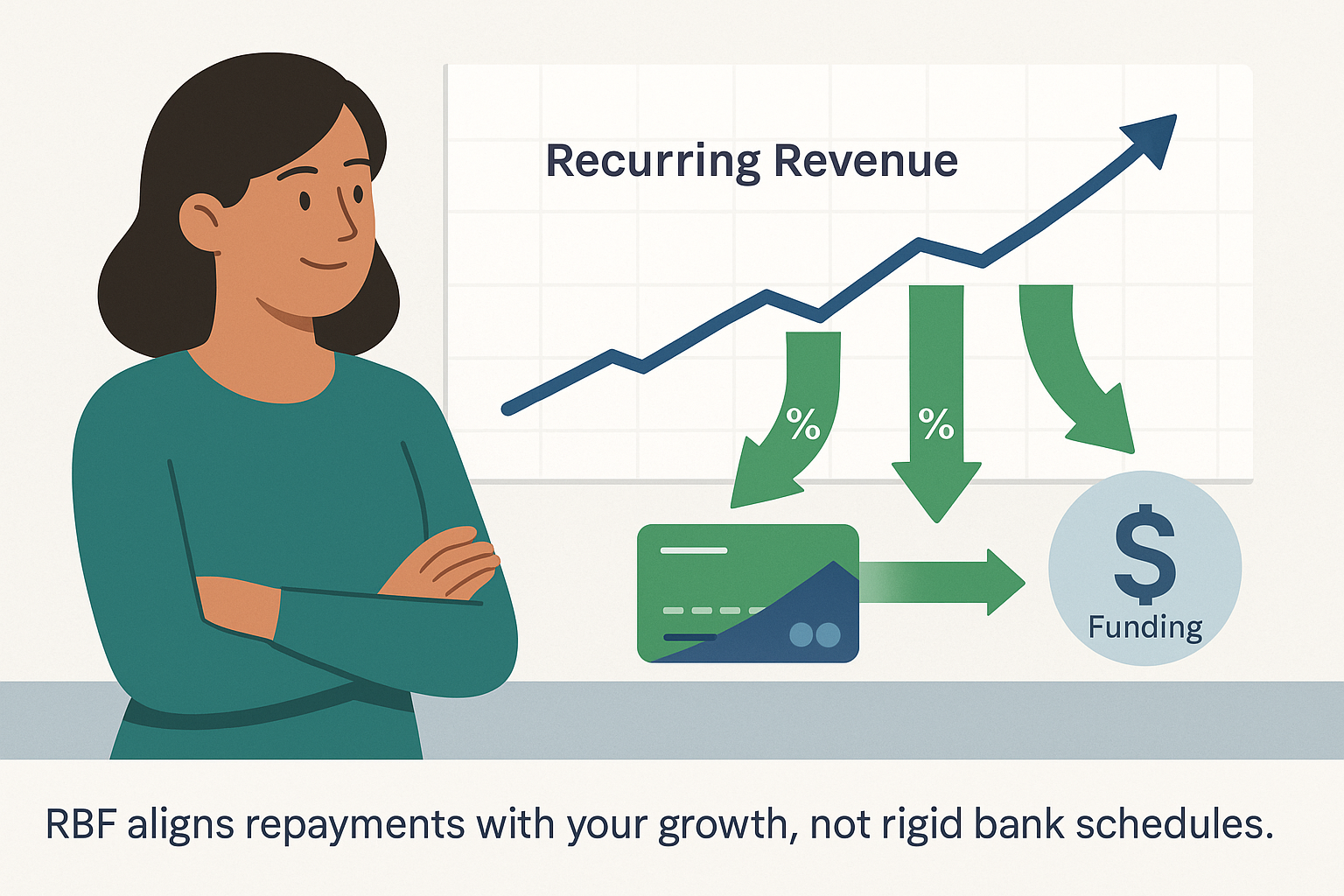1 (800) 584-0324
Startups and growth companies often struggle with the same challenge: they need capital to scale, but equity investors dilute ownership and banks demand fixed repayments. Enter revenue-based financing (RBF)—a non-dilutive funding model where repayment is tied to your company’s revenue, not a rigid schedule.
With the global RBF market projected to reach $778.9 billion by 2033, this approach is quickly becoming a mainstream option for SaaS, subscription, and recurring-revenue businesses. Let’s explore how revenue-based financing works and whether it’s the right tool for your growth.
What Is Revenue-Based Financing?
Revenue-based financing is an alternative lending model where:
- A lender provides upfront capital (often $50k–$5M).
- Repayments are made as a fixed percentage of monthly revenue (commonly 3–10%).
- Payments flex with sales—higher in strong months, lower when revenues dip.
- The obligation ends once a pre-agreed total repayment cap (e.g., 1.3x–2x the advance) is reached.
Unlike equity, you don’t give up ownership. Unlike a bank loan, you don’t face fixed installments that could strain cash flow.
Benefits of RBF
✅ Non-dilutive: Keep full ownership and control of your business.
✅ Flexible repayment: Payments scale with sales performance.
✅ Aligned with growth: Investors get paid when you succeed, not when you’re struggling.
✅ Faster approval: RBF providers prioritize recurring revenue and customer metrics over collateral.
✅ Great for SaaS & subscription models: Predictable revenues make repayment smoother.
Drawbacks of RBF
❌ Higher total repayment cost: Repayment caps can result in effective APRs of 15–30%+.
❌ Not ideal for all industries: Works best for recurring-revenue businesses, less so for cyclical or one-off models.
❌ Revenue dependency: If sales slow, repayment stretches longer, sometimes delaying exit strategies.
❌ Limited ticket size: Not suitable for very large capital projects compared to bank loans or private equity.
Revenue-Based Financing vs Traditional Loans
| Factor | Revenue-Based Financing | Traditional Loan |
| Remboursement | % of monthly revenue | Fixed installments |
| Collateral | None (based on revenue contracts) | Often required (assets, PGs) |
| Dilution | None | None, but rigid terms |
| Flexibility | High—scales with revenue | Low—must pay fixed amount monthly |
| Best for | SaaS, subscription, DTC brands | Asset-heavy or established firms |
Revenue-Based Financing vs Equity Financing
- Equity: Investors take ownership stake, returns tied to company valuation.
- RBF: No ownership loss; returns capped by repayment multiple.
- Takeaway: Use RBF for growth capital without dilution, and equity when strategic partners or very large raises are required.
U.S. and Canada: Revenue-Based Financing Market Snapshot
- U.S.: Strong ecosystem with providers like Clearco, Lighter Capital, and Pipe. Popular among SaaS, e-commerce, and creator economy businesses.
- Canada: BDC and fintech lenders offer RBF-style solutions, particularly targeting digital-first companies. Growing adoption among startups looking for non-dilutive funding to scale.
When Revenue-Based Financing Makes Sense
- You have predictable, recurring revenues (SaaS, subscription boxes, digital services).
- You want to scale quickly without dilution.
- You’re investing in marketing, customer acquisition, or product expansion.
Preparing for RBF Success
Before approaching revenue-based financing providers, ensure your financial house is in order. Clean, reliable revenue data is essential, AR/AP Records, so maintain updated bookkeeping, subscription metrics, and churn analysis. Providers typically review 12–24 months of revenue history, so highlight predictable growth and customer retention. Build a clear case for how you’ll deploy the capital—marketing, product development, or customer acquisition. A well-structured plan not only accelerates approval but can also improve repayment terms, helping you secure funding on the best possible footing.
More on Revenue-Based Financing
Looking for flexible, non-dilutive growth capital? Agile Solutions helps businesses in the U.S. and Canada access revenue-based financing, structure repayment models, and compare options against loans or equity.
👉 Book a consultation today at agilesolutions.global or email us at info@agilesolutions.global
#RevenueBasedFinancing #NonDilutiveFunding #SaaS #StartupFunding #GrowthCapital #BusinessFinancing #BDC #PrivateDebt #CapitalMarkets



